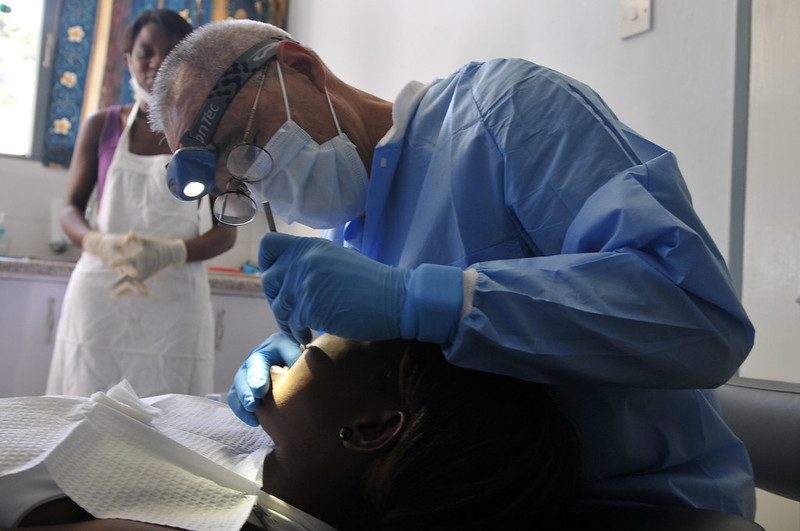An interesting article titled “Major Neurological Deficit Following Neck Hyperextension During Dental Treatment: Report of 2 Cases and Review of the Literature,” written by Victor G. El-Hajj and et. al. appears in the 2022 edition of the The Neurologist. The authors discuss two cases where patients had dental treatment performed and then suffered from neurological impairment due to hyperextension of the neck. Both patients had routine dental treatment done and had their necks overstretched which lead to a hopsital stay.
The first patient discussed was a 67 year old man who saw his dentist for bridgework. He had been taking a medication for high blood pressure for nine years but had no history of cerebrovascular events. The man’s dental work took around 45 minutes and he was given local anestheisia. His neck had to be extended during the procedure to allow for better reach into his mouth. Immediately after the dental work, the man was unable to stand upright and was experiencing vertigo and occipital headache. The man was taken to the emergency room for further evaluation. A neurological exam revealed he had dysmetria, a disturbance in the measurement of distances during muscular acts, involuntary eye movements, facial paresis, a positive Romberg sign, and difficulty swallowing. These symptoms indicated the man had lateral medullary syndrome. A magnetic resonance imaging (MRI) and magnetic resonance angiography (MRA) were conducted. The MRI showed an ischemic lesion in the lateral medulla and the MRA revealed complete occlusion of the right vertebral artery at the level of its fourth segment. The man was given heparin and improved and was discharged from the hospital after 17 days. When he left the hospital he still had a few gait issues and residual swalling problems. The man has done well since while taking daily a low dose of aspirin.

The second patient discussed was a 64 year old woman who saw a dentist because a prosthesis did not fit right. The woman was obese and a regular smoker for the past 40 years. The woman also suffered from diabetes and had been taking anxiolytics and antidepressants. When the dentist examined the woman she was found to have discharging pus and a fistulous tract in her left upper jaw-crest area. She had a dental x-ray performed which showed she had a wisdom tooth in the region that was unerupted. The woman had the wisdom tooth extracted and the fistula tract remova. This procedure required the woman’s neck to be hyperextended for 40 minutes under local anesthesia. The day after surgery the woman felt dizzy and lost her balance. The woman was taken to a hospital where a neurological exam showed bilateral Babinski sign, slight left facial paresis, and right dysmetria. An MRI of the neck did not show anything of interest but an MRA showed congenital hypoplasia of the right vertebral artery. Her symptoms resolved within two days. The woman was diagnosed with a transient ischemic attack and given a daily low dose of aspirin.
The authors state:
“Hyperextension of the neck for a prolonged period has repeatedly been shown to cause vertebrobasilar insufficiency and posterior circulation ischemia.”
The authors say that few cases of neck hyperextension leading to neurological complications have been reported in medical literature and suggests that other risk factors may play a role in the pathogenesis. They say that age, hypertension, diabetes, obesity, atherosclerosis, and smoking are risk factors for cerebrovascular diseases and should be considered risk factors for neck hyperextension leading to neurological complications. They also mention that vertebral artery hypoplasia, arthrosis, osteophytes of the neck joints, and cervical spondylosis could be other risk factors. The authors say that more awareness of the “Dental Chair Stroke Syndrome” as they call it could lead to more cases being reported. The authors suggest clinicians to be alert to symptoms like neckache, headache, vertigo, or blurred vision after dental work and that immediate medical care is provided in cases of ischemic attacks to potentially avoid severe irreversible damage. The authors suggest that if it is absolutely necessary to hyperextend a patients neck for dental work for a long period of time, that the patient be allowed to rest every 10 to 12 minutes or so. Dentists are also asked to ask patients about their history to be on the alert for potential risk factors.
It is noted that the authors say that it was observed in the 1990s that patients who see a hairdressor can experience a neurological deficit as a consequence of neck hyperextension during shampoo-baths. This condition has also be observed with chiropractic manipulation and even with stretching.
It is further noted that the authors appear to have missed a study by T. S. Tan and et al. titled “Acute sensorineural hearing loss immediately following a local anaesthetic dental procedure,” appearing in Eur Arch Otorhinolaryngol. (264. pages 99–102. 2007) which has been mentioned on this site for some time on the wisdom teeth complications page. In this article discussion is made of a 42 year old woman who had a dental procedure performed and then experienced hearing loss which was hypotheized to potentially stem from hyperextension of her neck during the surgery.
